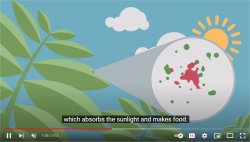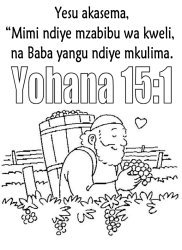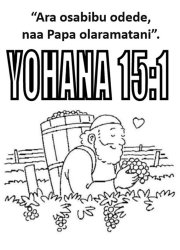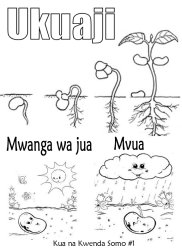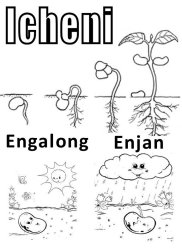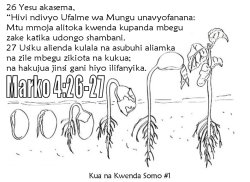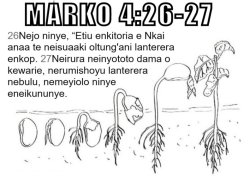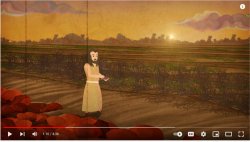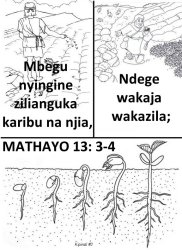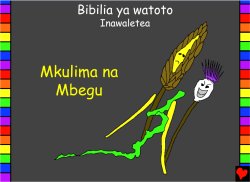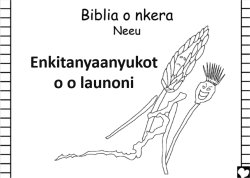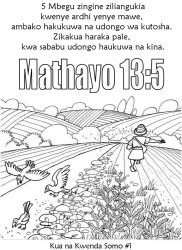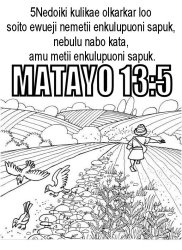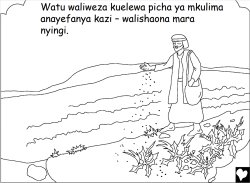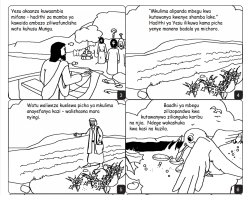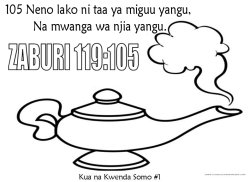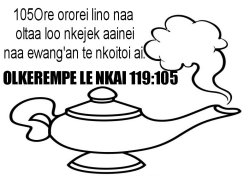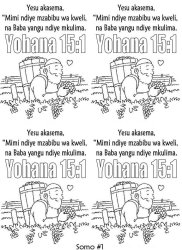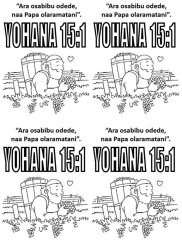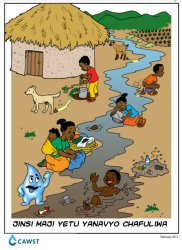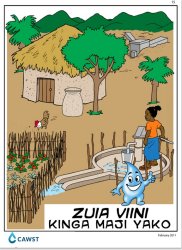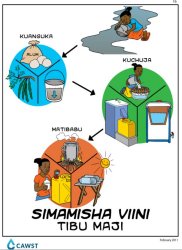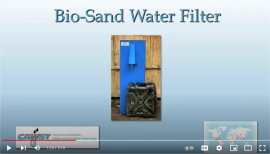
|
 Contact UsKukua na Kwenda MafunzoUinjilisti wa MtotoMmasai Mtaala Kukuza na KwendaKiswahili Mtaala wa Kukuza na KwendaTone la Matumaini
Mradi wa ShuleNchi ZilizochaguliwaHumanitarian Arm
Mtaala wa UCT |
nyumbani >>kua na kwenda maasai Kua na Kwenda - Maasai KUKUA NA UENDE UTANGULIZI ILI UKUE KATIKA ASILI NA KIROHO -
But it needs sunshine and water, just like we need the Light of the world and the Living water to grow Spiritually.
|
|
Ili kukua, kukuza na kuwa mmea mpya wenye afya, kila mbegu inahitaji viambato vichache vya msingi. Kumbuka watoto walijifunza kwamba wote wanahitaji aina tofauti za udongo, maji, mwanga wa jua, wakati na joto linalofaa ili kustawi na kukua. Botanists watakuambia kwamba udongo huamua afya na nguvu ya mmea. Udongo bora, afya zaidi, matunda zaidi na yenye nguvu zaidi mmea utakuwa.
Katika hadithi ya Yesu, mbegu inawakilisha neno la Mungu na udongo unawakilisha watu wanaosikia neno. Mara nyingi watu husikia neno la Mungu, lakini hawaelewi. Hawaichukui ndani. Hiyo ni kama mbegu kwenye njia ya waendao miguu. Yule mwovu huja na kuiondoa ile mbegu iliyopandwa mioyoni mwao kabla haijapata nafasi ya kukua maishani mwao.
Ile mbegu iliyoanguka kwenye udongo wenye mawe ni wale wanaolisikia lile neno na kulipokea kwa furaha kubwa, lakini hali hiyo mpya ikishaisha na msisimko huo kuisha, wao hupeperuka kwa sababu hawana mizizi.
Mbegu iliyoanguka kati ya magugu inawakilisha watu wanaosikia neno la Mungu na kuamini yale linalosema, lakini hivi karibuni ujumbe huo unasongwa na mahangaiko ya maisha na tamaa ya kupata vitu vingi zaidi. Mbegu ikipandwa kwenye kundi la magugu, magugu yatachukua nafasi hivi karibuni!
Mtu anayesikia neno la Mungu, anajaribu kuelewa linasema nini na kulifanya katika maisha yake ya kila siku ni kama udongo mzuri. Katika udongo mzuri, mbegu huota mizizi na kukua na kutoa mavuno mengi. Hiyo ndiyo aina ya udongo ambayo Yesu anataka tuwe. Wewe ni udongo wa aina gani?
Maji ni muhimu kwa mbegu kwa sababu ndiyo huisaidia kunyonya virutubisho kutoka kwenye udongo na ndiyo huisaidia kuota. Mbegu hufanya hivyo kwa kunyonya maji na kuvunja ganda ili kuchukua mizizi. Ndio maana katika Msururu huu tuna mfululizo mzima wa Swahili 'Kuza na Kwenda Maji' Mwangaza wa jua hutoa joto na nishati inayohitajika kwa mbegu kukua na kukua. Nuru ndiyo inayoionyesha njia iliyo juu na kuiruhusu kujua mahali pa kuweka majani yake. Pia husaidia kukuza matunda. Utajifunza yote kuhusu nuru na Nuru ya ulimwengu katika Msururu wa Swahili 'Kua na Uende Nuru' kwa Kiswahili. Muda ni muhimu kwa kuota na kukua. Muda ni mchakato. Huwezi kupunguza muda au kuharakisha; huenda kwa kasi yake yenyewe na kuruhusu mbegu kuota, kukua na kukua, mpaka kufikia ukuaji kamili na kuwa na matunda yenyewe.Hatimaye, joto ni muhimu katika mchakato wa kuota. Ikiwa mbegu iko katika mazingira ambayo hayana joto linalofaa, uwezekano wake wa kufaulu ni mdogo sana, hata kama vitu vingine vyote vipo. Ikiwa ni moto sana, itakauka na ikiwa ni mvua sana, itaoza. Hali zote mbili za kupita kiasi zitasababisha kifo cha mbegu. Viungo hivi vyote vitano ni muhimu, ikiwa mbegu itafungua ahadi kamili na uwezo inayobeba, na ikiwa itakua kama inavyokusudiwa kuwa. Ndivyo ilivyo kwa Mkristo. Tunahitaji viungo fulani ikiwa tunataka kukua na kukua na kuzaa matunda na kukomaa. Utajifunza zaidi katika Mfululizo wetu wa Swahili 'Kua na Kwenda Ukuaji wa Kiroho' Kumbuka:Kwa ukuaji wetu wa Kikristo pia tunahitaji nuru...
Hakikisha unaingiza Neno ndani yako, ili usiangukie mambo mabaya au kuingizwa kwenye makosa. Ficha neno la Mungu moyoni mwako ili usimtende dhambi (Zab 119:11). Mkristo pia anahitaji maji. Kwa nini ni muhimu? Kwa sababu kwanza sisi huja kwa Kristo, kutubu dhambi zetu, na kubatizwa kwa maji. Ubatizo wa maji ni muhimu kwa kila mwamini. Sio kile kinachokuokoa, lakini ni tendo la utii ambalo huweka muhuri wokovu wako. Lakini basi ni Roho Mtakatifu atendaye wokovu mioyoni mwetu. Kwangu mimi, maji ni picha ya Roho Mtakatifu. Roho Mtakatifu anatufunulia mambo katika Neno. Roho Mtakatifu anatufundisha. Roho Mtakatifu hutuongoza na ni ujazo wa Roho Mtakatifu ambao hutupa nguvu za kuishi maisha haya ya Kikristo. Yeye ni muhimu kwa kuzaa matunda kwa kila Mkristo. Ni katika maisha yetu yote ambapo Mkristo huchanua na kukua hadi kuwa mtu ambaye Mungu anakusudia na kuwapanga kuwa. Kupitia wakati, Mungu anaweza kuondoa ya zamani na kuachilia mpya ndani yetu. Tunabadilishwa kutoka daraja moja la utukufu hadi lingine. Ni kidogo kidogo, hivyo kuwa na subira katika mchakato. Mungu ni mvumilivu sana nasi.
Kila uzao hubeba ndani yake uwezo wote na ahadi ya kile inaweza kuwa - Kristo Kwanza Wiki ijayo tutaanza Msururu wetu wa kuwa 'Kuza na Kwenda Maji' Introduction to BioSand Filter WaterTeaching: This teaching will be introduced into the schools that will be supplied with our BioSand Filters compliments of ABCD in Africa. This weekly BioSand Filter teaching will involve educating the children all about the BioSand Water Filter, using PowerPoints and Visual Aids as well as videos and Handouts in Swahili to help them understand the importance of personal hygiene and water sanitation.
The consequences of unsafe water, sanitation and hygiene (WASH) on children can be deadly. Over 700 children under age 5 die every day of diarrhoeal diseases due to lack of appropriate WASH services. In areas of conflict, children are nearly 20 times more likely to die from diarrhoeal disease than from the conflict itself. Water, Sanitation and Hygiene (WASH) | UNICEF
Key Message: Water can be contaminated in many ways . Possible Questions: • Where does the water come from? • What does it mean when we say that water is contaminated? • What are the possible sources for water contamination? • Are humans the only ones contaminating the water? • Where do the people dispose of faeces? • Is it alright to defecate anywhere? • How can we protect the water that we use? Content: Water that contains microbes and other pollutants is contaminated. Human and animal faeces are the main source of water contamination. Water is contaminated when people and animals defecate in an open field or near a water source and when latrines are not properly used and maintained. The faeces get into the water and are spread to everyone who uses that water. Contaminated water can come through rivers, streams, wells and is carried to our homes in pipelines and buckets. Water can also be contaminated when: • Containers for storing water are not cleaned properly • Water storage tanks are not covered to protect against contamination • The bucket and rope that are used to pull water out of the well were in contact with something dirty (hands, animals, ground) Water can look dirty when it is contaminated, but even clear water can contain microbes that cause illness. Not all sources of water are good quality water. Rainwater is pure when falling from the sky, but may become dirty when landing on the roof. Groundwater can be of good quality, but may be contaminated with chemicals or latrine waste. Surface water is of poor quality because there are many so ways it can become contaminated. Check for Understanding: • Explain, in your own words, what contamination means. • Which sources of drinking water are easily contaminated? • Why are these water sources easily contaminated? • If you get water from a well, can microbes get into that well? How? • How can garbage contaminate our water? • What are some other habits that can lead to contamination of water? • If the water is clear, could it be contaminated?
Key Message: There are ways to protect our drinking water from contamination. Possible Questions: • Are there any activities you do to protect your water source? • Do you use a container to collect rainwater? • If yes, what type of storage container do you use? • Do you use a tapstand, well or pump to get your water? • If yes, is the well covered? • Does the pump or tapstand have a platform? • Is there a place for wastewater to go? Content: We have to protect our drinking water from contamination. To protect our water: • Keep a protected and covered well • Build a platform under the pump or tapstand • Build a channel to divert wastewater • Build a soak pit for wastewater • Protect your spring by building a catchment box • Collect rainwater in covered tanks • Use a clean rope and bucket to pull water out of a well • Keep animals away from our water sources by using fences • Maintain a separate area for animals to drink • Take care of the yard and general environment around the house • Protect the source of water by planting trees along creeks and rivers • Maintain a well forested area above your water source If we do these things, the quality of the drinking water that we consume will be better, but we still may have to treat the water to make sure it is safe to drink. Check for Understanding: • How can we protect our water sources? • What should we do with wastewater from our water source? • How do we protect our spring sources? • How should rainwater be collected and stored? • Why do we cover wells? • Why should we have a platform underneath a pump or tapstand? • Why would we use a soak pit?
Stop Microbes - Treat Your Water Key Message: Contaminated water can be treated to make it safe. Possible Questions: • Do you treat your drinking water? • Have you heard of any ways to treat your drinking water? • Are you satisfied with your drinking water? Content: It is important to treat your water to ensure that it is safe. Treating our water helps remove microbes which make us sick. Water can be treated in several different ways. Some ways are easy or fast but other methods can be hard and more expensive. Which ever way is used to treat water, it must be done well and correctly. If it is done correctly and consistently, you should always have good water to drink. The first step in treating your water is to perform sedimentation. When our water is dirty we need to sediment our water. Microbes like to stick to sediment, so by removing the sediment we are removing microbes. We can sediment our water using seeds, prickly pear cactus, or chemicals. These will help remove sediment and make the water more clear. After sedimentation, it is necessary to filter our water to remove more microbes. We can filter our water using many methods. Some methods of filtration are straining the water with cotton cloth, using a biosand filter, or using a ceramic filter. Although the water may look clear after filtration, it is still necessary to disinfect our water. Disinfection can be done by boiling, adding chlorine or using solar disinfection (SODIS). If we have performed all three steps, we know that our water is safe to drink. There are different treatment methods, so we can choose which way is best for our family. Check for Understanding: • Why should we treat the water? • What are the three steps to treat our water? • If our source water is clear, can it still make us sick? • How do you remove microbes? • Why are there different water treatment methods?
Wiki ijayo tutaanza Msururu wetu wa kuwa 'Kuza na Kwenda Maji'
GROW AND GO CURRICULUM
|
| Copyright © 2024 www.UnitedCaribbean.com. All rights reserved. Disclaimer Click to Contact us |
